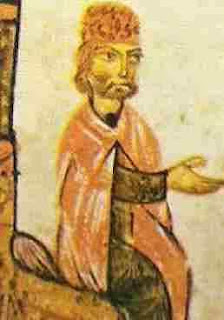The battle in the Bosnian Highlands took place at the beginning of May 927 between Croatian and Bulgarian forces.
The battle in the Bosnian Highlands took place at the beginning of May 927 between Croatian and Bulgarian forces.
Emperor Simeon of Bulgaria captured much of Byzantine territory in Europe and crowned himself "Emperor of Bulgaria" in 913.
In 924, Simeon sent a large army against Zaharia in the Principality of Serbia. The Bulgarian army ravaged Serbia and forced Zaharia to flee to Croatia, and Serbia was annexed to Bulgaria.
In 924, Tomislav defeated the Hungarian duke Zsoltan in Lower Pannonia and annexed it to his state.
After Emperor Romanus I Lekapenos granted him some form of control over the coastal cities of the Byzantine theme of Dalmatia and was rewarded with a portion of the tribute collected from the cities, Tomislav proclaimed himself king around 925.
Tomislav received and protected the Serbs who were expelled by Simeon.
For Simeon, these events were proof enough that the Croats had sided with the Byzantine emperor and that they would actively support him in the future. Therefore, Simeon perceived Croatia as a threat and could not direct all his forces towards Byzantium because nothing could prevent Croatia from striking his rear.
In the spring of 927, Simeon sent a large army on an expedition to Croatia under the leadership of Duke Alogobotur.
The decisive battle took place in today's southwestern Bosnia around Livno and Tomislavgrad, where the later Bulgarian invasion of Croatia took place in 998. This direction of movement of the Bulgarian army leads directly to the heart of Tomislav's state, i.e. to Dalmatian hinterland.
The battle itself was fought from an ambush, Tomislav's forces completely destroyed the Bulgarians. Probably the key to the overwhelming victory was the choice of terrain on which the battle took place. At the moment when the battle started, the Bulgarians were in a disadvantageous position and the Croatian army launched a surprise attack on them.
The Croats adapted their military tactics, the time and place of the battle to their opponents, who may have outnumbered them, thus giving themselves a decisive advantage.
According to the (often misinterpreted) data in the DAI, by the middle of the 10th century, Croatian rulers had 60 cavalry and 100 infantry allagions at their disposal. According to the chronicles of Priest of Dioclea from the 12th century, each Croatian zupania provided a squadron of 100 horsemen under the command of a satnik who was subordinate to the zupan.
Ban, who ruled over 3 zupanias, had 7 satniks at his disposal, as well as the king.
The total size of the "professional" army at the ruler's disposal was 2,500-3,000 soldiers.
According to the estimates of contemporary historians, 10,000 soldiers from both sides took part in the battle. Most of the Bulgarian army perished, as did Duke Alogobotur.
Bulgarian Emperor Simeon died on May 27, 927, according to some chroniclers, after receiving the news of the destruction of Alogobotur's army.
His successor Peter I continued to war with Byzantium.
The Croatian-Bulgarian war did not continue in a significant extent and peace was concluded after the death of Emperor Simeon. In 927 Pope John X sent his legates with Bishop Madalbert to mediate between Croats and Bulgarians.
















Comments
Post a Comment